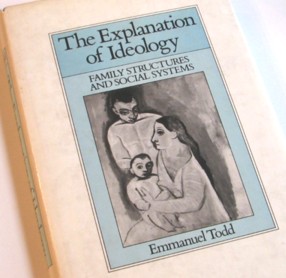 This, the second of my Emmanuel Todd postings here, will confine itself to itemising the eight family system classifications that appear at the start of most of the chapters of The Explanation of Ideology. Each clutch of information lists the distinguishing features of each family system, and the places where each system prevails.
This, the second of my Emmanuel Todd postings here, will confine itself to itemising the eight family system classifications that appear at the start of most of the chapters of The Explanation of Ideology. Each clutch of information lists the distinguishing features of each family system, and the places where each system prevails.
If this posting seems strange, see my previous posting, Emmanuel Todd (1): Anthropology explains ideology, for some clarification.
So here are those family systems. I will here add only that “exogamous” means marrying outside your family and “endogamous” means marrying within your family.
Characteristics of the exogamous community family:
1. equality between brothers defined by rules of inheritance;
2. cohabitation of married sons and their parents;
3. however, no marriage between the children of two brothers.Principal regions concerned: Russia, Yugoslavia, Slovakia, Bulgaria, Hungary, Finland, Albania, central Italy, China, Vietnam, Cuba, north India.
. . .
Characteristics of the authoritarian family:
1. inequality of brothers laid down by inheritance rules, transfer of an unbroken patrimony to one of the sons;
2. cohabitation of the married heir with this parents;
3. little or no marriage between the children of two brothers.Principal regions and peoples concerned: Germany, Austria, Sweden, Norway, Belgium, Bohemia, Scotland, Ireland, peripheral regions of France, northern Spain, northern Portugal, Japan, Korea, Jews, Romany gypsies.
. . .
Characteristics of the egalitarian nuclear family:
1. equality of brothers laid down by inheritance
rules;
2. no cohabitation of married children with their parents;
3. no marriage between the children of brothers.Principal regions: northern France, northern Italy, central and southern Spain, central Portugal, Greece, Romania, Poland, Latin America, Ethiopia.
. . .
Characteristics of the absolute nuclear family:
1. no precise inheritance rules, frequent use of wills;
2. no cohabitation of married children with their parents;
3. no marriage between the children of brothers.Principal regions: Anglo-Saxon world, Holland, Denmark.
. . .
Characteristics of the endogamous community family:
1. equality between brothers established by inheritance rules;
2. cohabitation of married sons with their parents;
3. frequent marriage between the children of brothers.Principal regions: Arab world, Turkey, Iran, Afghanistan, Pakistan, Azerbaijan, Turkmenistan, Uzbekistan, Tadzhikistan.
. . .
Characteristics of the asymmetrical community family:
1. equality between brothers laid down by inheritance rules;
2. cohabitation of married sons and their parents;
3. prohibition on marriages between the children of brothers, but a preference for marriages between the children of brothers and sisters.Principal region: southern India.
. . .
Characteristics of the anomic family:
1. uncertainty about equality between brothers: inheritance rules egalitarian in theory but flexible in practice;
2. cohabitation of married children with their parents rejected in theory but accepted in practice;
3. consanguine marriage possible and sometimes frequent.Principal regions: Burma, Cambodia, Laos, Thailand, Malaysia, Indonesia, Philippines, Madagascar, South-American Indian cultures.
. . .
Characteristics of African systems:
1. instability of the household;
2. polygyny.
Concerning the “African system” Todd starts his (very short) chapter thus:
Given the present state of anthropological knowledge no exhaustive, detailed analysis of the interaction between the family structures and political systems in Africa is possible.
But hasn’t Africa been overrun by anthropologists in recent decades? Yes. However:
Paradoxically, the Dark Continent, an area of fundamental importance in anthropological research, remains very poorly documented from the point of view of family structure.
That vagueness aside, I find the above list very impressive. Do I need to note the correspondence between, e.g., the list for the exogamous community family and communism, just as a for instance? In later postings, I will spell out in more detail why Todd’s body of work so excited me when I first encountered it in the 1980s. I will offer (more) guesses as to why it has been neglected.
Once I have accumulated a decent number of Emmanuel Todd postings here to link back to, I will start beating the Emmanuel Todd drum in more public places, until such time as an Emmanuel Todd blog-buzz gets seriously buzzing. (That’s three “Emmanuel Todds” in one short paragraph, and now four. Should I start calling him “ET”?)
A very quiet buzzing can already be detected. See item 2 here.

A comment from a bibliophile:
I hope that’s a 1st edition you’ve got there, it’s a pretty rare and valuable book.
Posted by Harry Powell on 02 February 2007